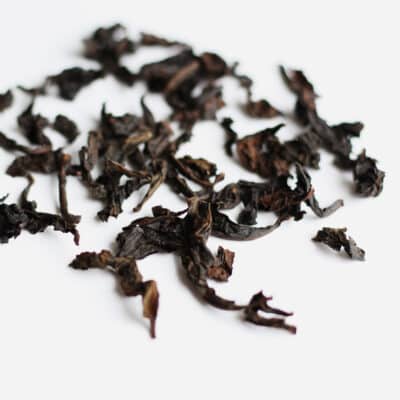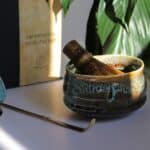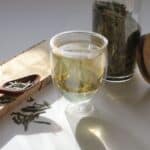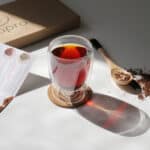18 Sep Our Da Hong Pao Tea Adventure
Da Hong Pao Oolong has always intrigued me – its deep history, legendary status, and the breathtaking, almost magical mountains where it grows make it a tea like no other.
During our trip to China, we had the exciting opportunity to experience this tea up close, and it was nothing short of extraordinary!
A Town Obsessed with Tea
When we arrived in Wuyi, we couldn’t help but notice that EVERYONE in the area either works in tea or knows someone who works in tea.
The town was a sea of tea shops – one after another, stretching as far as we could see. I lost count, but there must have been close to a thousand of them. It was truly incredible to witness – tea isn’t just a part of life here; it is life.
So I guess it shouldn’t have been surprising that the family who run the hotel we stayed in… had their own tea farm.
And it so happened that they were reviewing their tea harvest on the day we arrived! It was fascinating to see them smell and taste the tea, prod at the leaves and test how many re-steeps the tea can take.
They also rated the tea (probably to decide which one they’ll sell at a premium) and we were lucky enough to try and review the teas with them!


The outside area of this hotel was the most stunning part of it – with tea tasting areas everywhere and a beautiful view on the Wuyi Mountain (see the banner photo).



Impression Da Hong Pao
Later that day, we headed to the local theatre to check out a very unique performance, which was… you guessed it – tea themed.
Remember how in my previous article about China I mentioned that they do everything the opposite way to us? Well, at least they are consistent in that!
The theatre was an open-air masterpiece, with the audience seated at the heart of it all, completely surrounded by the stage.
As the performance unfolded, the audience area itself rotated, revealing new parts of the stage, each scene illuminated in breathtaking ways.
At one point, they even incorporated the majestic Wuyi Mountain into the performance, seamlessly blending nature into the spectacle.
Obviously, the show itself was in Chinese, so we didn’t understand a word. Luckily, the main focus of the show was the light effects and the amazing choreography, which by the way was the work of the famous Yimou Zhang, who also directed the opening and closing ceremony of the 28th Olympic Games in Beijing.



Da Hong Pao Mother Trees
Next day, we did the Da Hong Pao Tea trail!
Nestled among the proud protruding mountains of Wuyi and the 9 Dragon Cave is where it all started – the Legend of Da Hong Pao.

And there they were – the 6 mother trees of Da Hong Pao, effortlessly growing all the way up on the side of the mountain.
They are considered one of the national treasures of China. The tea from these trees is so precious, that in 2005 it was auctioned for an astonishing £22.6k (¥208,000) for just 20g!
The year after, the government decided to stop the harvest in order to protect the trees, whilst also insuring them for a value of ¥100 million (approx. £10 million).
So you can really tell how much those trees mean to them.



Enjoying this adventure? Want to her more about our travels? Read more about our trip to China and find out why it was not what we expected!
Da Hong Pao Tea Trail
The trail itself was nothing short of stunning!
It was so lush and green with different cultivar tea bushes growing all around!
The teas harvested from that specific mountain region sell for astronomical amounts and are very limited in supply.
What I found most fascinating is how many different cultivars of Da Hong Pao there are! I counted 20 of them during our trail, but I’m sure there are more!
Each cultivar has something unique about them. For example, Rougui is known for the most fragrant aroma, Shuixian has the most mellow taste etc.
The most common Da Hong Pao (the one we sell on teapro) is a combination of several cultivars, as it ensures the most consistent flavour.
However, if you harvest the tea from just 1 cultivar, it becomes more expensive AND if you harvest the tea from 1 tree (especially if it’s an old tree), then you’re talking thousands of ££££. I am not even joking.
Why? Partly because its more labour intensive, more scarce and also the character from each individual tree really shines through. Also, the older the tea tree, the more intense the flavour and the more re-steeps the tea can take!





Our passion for traditional blends runs deep – discover the timeless beauty of our collection of Chinese herbal tea.
Tasting Da Hong Pao
A tea shop in Wuyi is not like any tea shop you’ve ever seen.
There is hardly any products on display. Instead there is a huge wooden table prominently placed in the middle of the room, usually complemented by an exquisite tea tray with a Gong Fu tea set.
When you walk into a shop like this, you already know your bank account will be a few hundred pounds lighter on your way out…
Lucky for us, during our Da Hong Pao trail we made friends with a local Chinese guy! His Eastern European friend was visiting him, so he was just showing him around all the touristy spots!
And of course, he had a friend who owned one of these tea shops. Oh serendipity! Or shall I say serendipi-tea?
(By the way, he also had a friend who runs his own Da Hong Pao tea factory, but that’s a story for another day.)


When we were tasting the teas, I was too scared to ask for the price (I kinda already had a feeling it won’t be cheap).
Since we were there with our friend, we were not forced to buy anything – which in retrospect was unbelievably generous!
A few days later I asked our Chiense friend if he knew the prices of the tea and he sent me this…

Ok, before you get a heart attack – those are prices for 1 kg of that tea… but still.
The one to the very right (in yellow packaging) is actually a black tea (rather than Oolong) that was harvested from a single tree.
The one in the red packaging is a “generic” Da Hong Pao with several cultivars.
The one to the left of it is made from single cultivar ROUGUI and the most expensive one is from an old tree, also single cultivar.
Were they delicious? YES!
Could we taste the difference? YES!
Would I say that the more expensive one tasted better than the rest? I’m honestly not sure…
I think at this point you’re paying for the story and the prestige.
(I guess it’s the same principle with expensive wines.)
All I can say is that we learned A LOT about Da Hong Pao and had the best experience AND also made some amazing friends!

If you’re interested to find out what the national treasure of China tastes like, you can find delicious Da Hong Pao in our shop (or you can try it as part of our Oolong-Wulong tea gift box)



Teapro co-founder. Favourite tea - Long Jing Dragon Well Green Tea. Obsessed with film, photography and travelling.
















Frank Baker
Posted at 09:44h, 20 SeptemberNow you know why I visit China so often 🙂
Tatjana
Posted at 10:52h, 23 SeptemberYes, I totally get it! Need to start planning our next trip soon! hehe